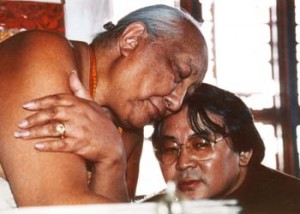A Book of Devotion
A remarkable key feature of The Tibetan Book of Living and Dying, aw well as all of Sogyal Rinpoche’s teachings, is the frequency with which he invokes the memory and presence of his masters, and the environment this creates through which we can, in some small way, come to meet them ourselves.
From the memorable childhood stories with his master Jamyang Khyentse Chökyi Lodrö, to the poignant account of Dudjom Rinpoche’s passing (Chapter 9), to the example of embodied devotion in Khandro Tsering Chödrön (Chapter 9), these masters’ presence pervades The Tibetan Book of Living and Dying.
As Rinpoche wrote in “Introduction to the Revised Edition” (2002), reflecting on the impact of the book in those first ten years since its publication:
As The Tibetan Book of Living and Dying quietly took on a life of its own, moving inconspicuously through many domains and disciplines, I began to understand the ultimate source of its great influence and appeal. These extraordinary teachings are the heart essence of the oral lineage, that unbroken line of wisdom passed down as a living experience over the centuries. Someone once called this book “midway between a living master and a book,” and it is true that both in The Tibetan Book of Living and Dying and behind it, supporting it with their advice and answers to questions, are the greatest masters of our time. It is their voice that speaks through these pages, their wisdom and their vision of a compassionate world infused by the knowledge of our true nature, the innermost nature of mind. The impact of The Tibetan Book of Living and Dying, I believe, is due to the blessing of the lineage and the vibrancy of the oral tradition. Its popularity has been a humbling experience for me, and it has reminded me that if I have any ability to communicate these teachings, it is only because of the devotion inspired in me by the teachings and the kindness of my masters, and nothing else.
In honor of the lives of these great masters, of the great kindness of the teachings they have left behind, and in celebration of The Tibetan Book of Living and Dying as , over the coming weeks we will present Remembering the Masters – a series of short teachings by Sogyal Rinpoche on each of these masters.
This series will begin with video post on Jamyang Khyentse Chökyi Lodrö who, in the preface to the book, Rinpoche calls the ‘the ground of my life, the inspiration of his book’.

